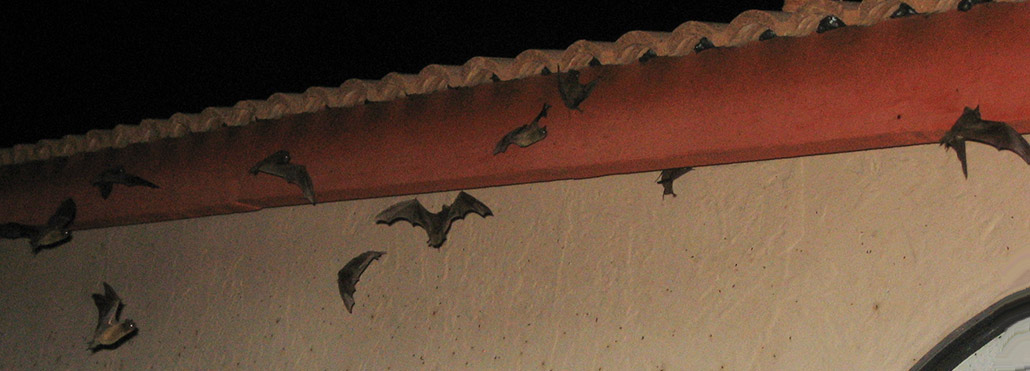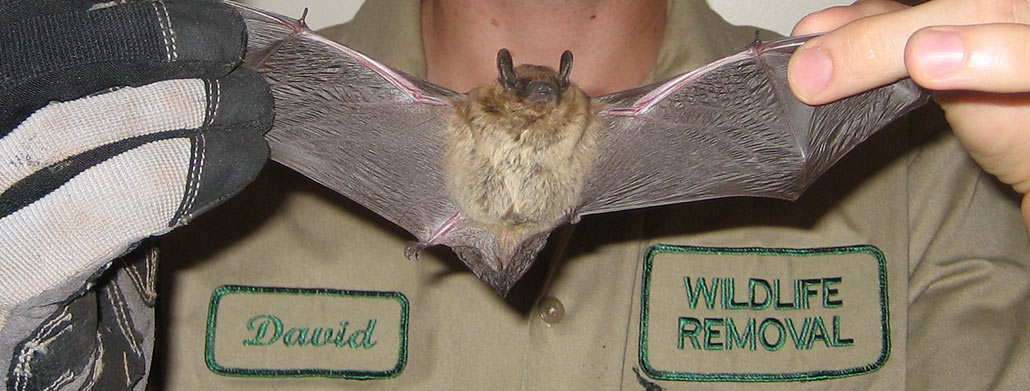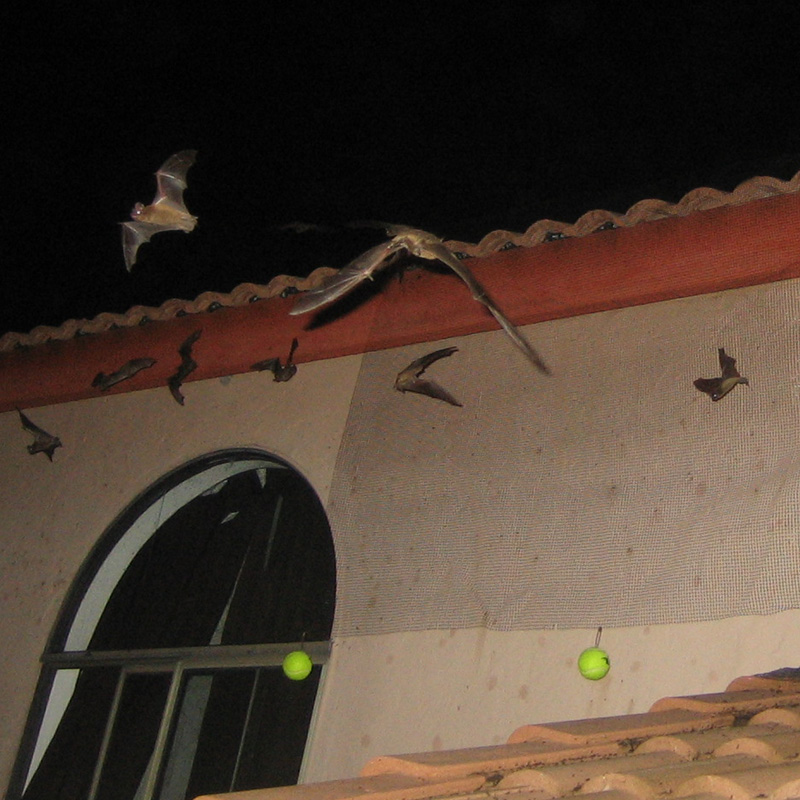- USA Wildlife Removal Education Guide and Resources
How to Get Rid of Bats
SIX STEPS TO GET RID OF BATS:
- STEP 1 - Inspect inside the attic, and observe the house at dusk and danw, to identify the species of bat and the entry and exit holes they use to enter the building.
- STEP 2 - Climb a ladder and climnb the roof and identify all entry holes and gaps, as small as 3/8". Seal most of these areas shut with caulk or other sealant. Leave the primary exit holes open.
- STEP 3 - Install the appropriate one-way exclusion doors on the primary exit holes. Could be funnels, screens, or nets depending on architecture. The bats must be able to fly out but not back in.
- STEP 4 - Watch the bats at dusk and dawn, to ensure that they can properly get out, but not back in. If there's a problem, remove the one-way doors immediately, and re-position after a day or two.
- STEP 5 - Leave the functional exclusion up for at least 3 days. Once you are certain all the bats are out, remove the exclusion devices and seal the holes and gaps shut.
- STEP 6 - Clean and decontaminate the attic. Remove all guano, and fog or spray with an enzyme cleaner.
Bats in the attic are usually female bats looking for a safe place to raise their young. There are a lot of legal issues when it comes to bat removal, and this is one situation that is best left to the professionals. Bat colonies are protected by law and cannot be killed or relocated. The best way to eliminate bats from an attic is by installing a one way door which will let the bats exit the building but not re-enter. This process may seem simple, but it cannot be done when baby bats are present or you will have a number of baby bats starving to death inside your attic. Bats will remain in a roost year round if it is warm enough, and if not, they will migrate away but return in the spring. This is why is it so important to seal up your attic so bats cannot enter and become nuisances.

How to Get Rid of Bats in the Basement
Basements are similar to caves; dark and usually a constant temperature. Bat colonies are drawn to this type of environment. Once they find a roost, bats are reluctant to leave and they will return to the roost every year if it is accessible. Preventing access is the only real method of bat control since the animals are protected by a number of laws and regulations. You cannot legally kill bats and they cannot be trapped and relocated. So what does this mean for bat removal? The only effective means of bat removal is the installation of a one way door at the exit points of the basement. The adult bats will be able to leave but won’t be able to return. Potential complications with this involve the presence of baby bats. Baby bats won’t leave the basement with the adults and if the adults can’t return, the baby bats will eventually die. In large colonies, this can mean hundreds of dead baby bats decomposing in your basement. For effective bat removal, it is recommended that you employ the expertise of a professional to help minimize this type of dilemma.
How to Get Rid of Bats in the House
A trapped bat in the home is not uncommon, especially during the warm summer months when homeowners leave windows open after dark. If a bat has flown into your home, do not swat the animal with a broom or other tool, and do not sic your house cat on it. Pick a room in your home with large windows. Turning off the lights, guide the bat into the chosen area, opening all the windows. Leave the bat in there for the night. Chances are the animal will be gone in the morning. If the bat is injured while in your home or is reluctant to move or fly, place a vented box or container over the rodent and call a wildlife rehabilitator. Do not handle the bat. In many areas of the country bats are the primary carrier of rabies. Handling a bat unnecessarily can result in potential health concerns. Most counties will require you to report bat exposures and may require the bat to be euthanized and tested to the virus.
How to Get Rid of Bats in the Barn
Barns are another primary place for bats to set up residence. Barns often have high roofs with lots of beams and hidden places. Hay lofts are only disturbed once or twice yearly, making the rafters dark and dusty roost areas. Bats in the barn can be very difficult to remove because of the nature of the barn itself. Most livestock sheds are left open for the large animals to come into at will. This open-all-the-time policy can make bat control impossible. For bats in the barn, the barn must be able to be sealed during the hours of bat activity: dusk and dawn. The doors of a barn are not usually the exit points for bats. Watching where the rodents emerge from the building will key you into where your one way door trap needs to be installed. Excluding bats from the barn is the only way to eliminate them. Bats cannot be poisoned and they cannot be trapped and relocated. Legally, bat colonies are protected and can’t be moved or killed. This makes bat control difficult. Most bat situations warrant the help of a professional. Even if you are able to install the one way doors to keep the adults from coming back, baby bats left behind can cause serious problems when they crawl into corners and die. A professional will be able to tell if baby bats are present and will be equipped to go in and removed the entire colony.

Go back to the main Bat Removal page for more information about how to get rid of bats. You might also want to read these articles I wrote after years of experience with these creatures. Learn what to do about Bats in the Attic and whether Bats are Dangerous. Read my advice on How To Get Rid of Bats and what to do about a Bat in Your House or your Chimney. Learn about Bat Boxes and the Bat Maternity Season.
Learn from me the best methods of Bat Prevention and the different Diseases bats can carry. Learn about their Feces and when necessary How to Kill a Bat. Learn about Bat Repellents and how to Trap a Bat. Protect yourself from Diseases Bats Carry and learn what areas of the house bats typically enter through. Find out how to keep bats out of a Barn, and whether or not you should ver trap a Bat in a Cage.
Learn the Biology of Big Brown Bat, the Biology of Little Brown Bat, and the Biology of Mexican Free tail Bat. Find out if bats are really blind, and if they will chew on wires. Read what to do with a bat after you Catch It in your House, and what to do about a bat stuck in the Fireplace. Learn about bat maternity colonies and how bats communicate, as well as if repellents will get a bat out of your attic.
How to get rid of bats in buildings: Having bats in a building is a complicated and serious issue when you compare it to other nuisance wildlife problems that you can face. In order to handle the issue properly, you need to determine what bat species inhabit your attic, ensure there aren’t any baby bats, and then find out what is the best way of safely removing the bats from the attic. You need to handle the entire colony if you are to eradicate the problem completely. Once they have been removed, sealing the openings and thoroughly cleaning the attic should be done to totally eliminate the threat that lies within.
Even though the process above has been laid out with such simplicity, it is usually a very detail oriented and complex process that has to be done and done well. Even people with experience may find that they are having a difficult time dealing with the problem.
The process isn’t simple, but with the correct ideas and tools, you should be able to handle the infestation in the easiest possible way. You will have to find the entry and exit points that the bats are using to enter the attic area. You should seal out the holes, leaving only one. The biggest hole is the best one to leave open and then place a one way device over it. In this way, the bats are able to fly out but they cannot make their way back in. You should never carry out this process in cases where there are baby bats or you will be dealing with an even bigger issue. It is also against the law in most places.
The reason why you should never eliminate the bats while there are young ones involved is due to the fact that they are not able to crawl out of the exit hole and they cannot fly yet. They are also dependent on the mothers until such a time that they are weaned and are able to go out and forage for themselves. If left in the attic without the adults, they will get dehydrated, starve to death, or even crawl in other parts of the house and die there, creating a serious stench.
The best one way exclusion has to be made to perfection for it to work well. Once all the bats have moved from the attic, seal out all the holes and do a thorough cleaning of the attic. Always wear protective clothing when doing this.


